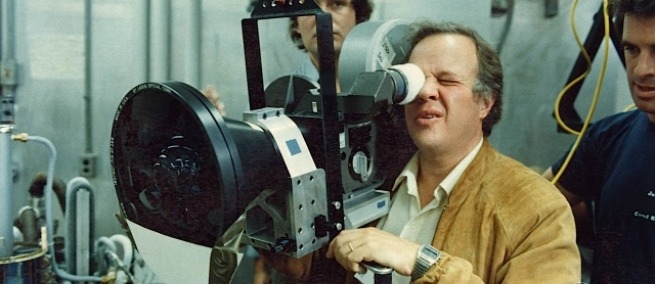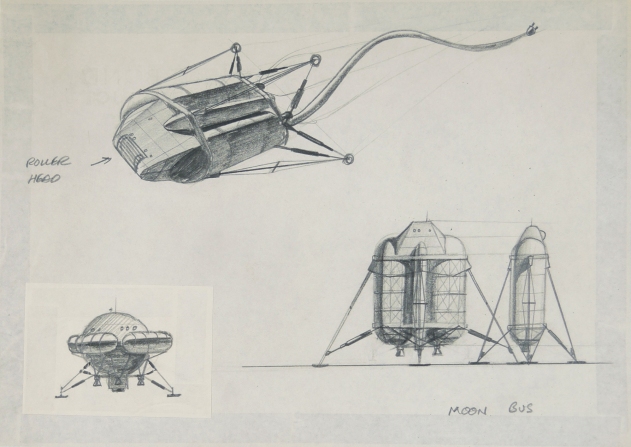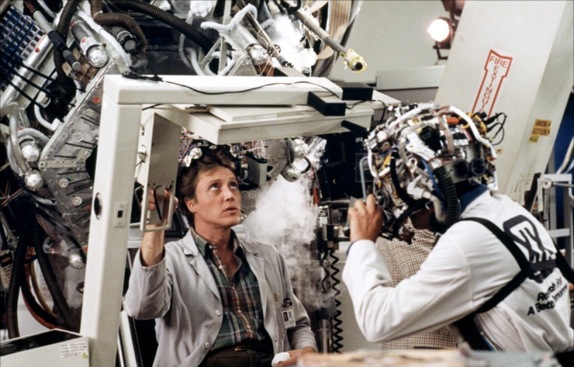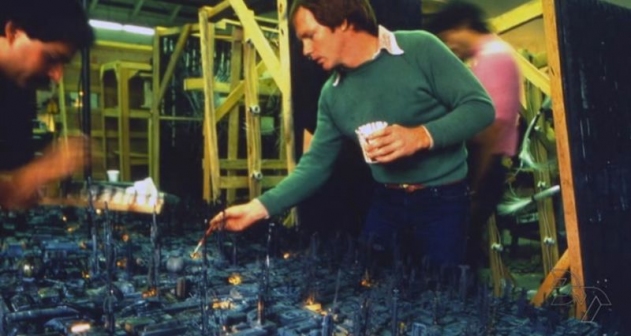
Douglas Trumbull is a visual effects and immersive media pioneer who was mentored by Stanley Kubrick. His career began at Graphic Films, a Los Angeles-based company founded in 1941 by a former Disney animator Lester Novros in 1941, which made animated and live action non-theatrical films. Trumbull is best known for his work as the Special Effects Supervisor on 2001: A SPACE ODYSSEY, CLOSE ENCOUNTERS OF THE THIRD KIND, STAR TREK, and BLADE RUNNER. He also directed the visionary movies SILENT RUNNING and BRAINSTORM.
Science & Film recently featured an article about the history of Graphic Films and the inception of 2001: A SPACE ODYSSEY. Museum of the Moving Image currently has an exhibition of the original drawings Trumbull and others at Graphic Films made for an 18-minute film TO THE MOON AND BEYOND, which screened in a custom-built dome at the 1964 World’s Fair. Correspondence about that project led to Trumbull working for Kubrick, who had begun to plan for his 1968 masterpiece. Science & Film spoke with Trumbull over the phone from his home in the Berkshires, where he has created a new filmmaking technology called Magi.
Science & Film: Thinking about your work on TO THE MOON AND BEYOND, and now with Magi, I notice that you are interested in making films that can’t be shown in a traditional movie theatre. What do you see as the limitations of “normal” cinema?
Douglas Trumbull: The convention of a motion picture exhibition as well as television is a rectangular flat screen. The field of view to the viewer’s eyes is rarely more than about 50 degrees wide. That’s not what I call an immersive experience. TO THE MOON AND BEYOND, which was screened in a dome that included your entire field of view (the dome was 180 degrees), was extremely wide, and Cinerama in its day was over 100 degrees wide. I was profoundly affected by that as a kid and thought, why don’t we have more of that? So as a professional filmmaker myself, I wanted to see if there was a way to make a movie technology that was user friendly, inexpensive, and that would be within the realm of conventional cinematic language that directors and cinematographers understand. Shooting with a fisheye lens is really a pain in the neck. I wanted to come up with a hybrid that had all the attributes that I wanted of an extremely wide 100 degree field of view, a tall image, high brightness, high frame rate of120 frames, high resolution, and powerful sound. So that, in the totality of it, you have 100 times more information available to the viewer than a conventional 24-frame movie or television show. The result is a more subjective and immersive experience. That triggers the opportunity to make movies that are much more participatory in the sense that 2001 was.
Working with Stanley Kubrick on 2001: A SPACE ODYSSEY, a 100-foot wide screen and Cinerama created an opportunity for a more immersive experience. I realized that storytelling, drama, and other classical conventions of cinema could be set aside in favor of letting the audience feel like they were inside the movie instead of watching the movie. So that is what I’ve been trying to do for 50 years and finally figured it out. But it does really require a reconsideration and reevaluation of what it is to be in a movie theatre. Movie theatres are historically a rectangular flat screen at the end of a box. Even the theater at the Museum of the Moving Image, which I rate as one of the best theaters on the planet, architecturally just does not offer that experience because it’s still the same thing, only done better.

S&F: I saw you speak at the New Museum’s Versions conference on Virtual Reality. What did you think of the conference?
DT: I really got a lot out of it. I am becoming fascinated now with this whole emerging world of Virtual Reality (VR) and Augmented Reality. I wanted to see what people were doing, what they were saying, and understand more about the technology. It was very informative and useful because I’m very curious about the human desire for experiences that transcend everyday reality, which is what I think VR is all about. I think people are finally getting bored with television–it’s ubiquitous and it’s very conventional in many ways. The story, the plot structure, the dramatic styles, photography, are all almost interchangeable from movie to movie. There is nothing really new and groundbreaking going on. It’s like an engine that is running out of steam. I think it’s time to reenergize it by abandoning a lot of old conventions and saying, what if you could look all around? What if you could interact with it in some way? What if you could control part of what’s happening? What if you were one of the characters in it? I think that is what people are seeking, and I think it’s a completely new industry that’s very interested in what I’m trying to do, but it’s coming at it from a VR angle. It’s all enabled by smartphones and digital displays and computer graphics. Whereas I have still got one foot deeply entrenched in cinema, in the sense that I like the idea that there is an actor, a director, and a producer. I’m just trying to find out what the common ground is between these two worlds.
S&F: You said that your career got started at Graphic Films and that Stanley Kubrick, who was such a genius cinematically, was your mentor. That combination speaks to where you have ended up.
DT: Yeah. What would a VR experience be if Kubrick directed it? We should be so lucky. I think he would be thrilled. What if 2001 was a VR experience? It could have a developing plot, a story structure like the movie has, but you would start out in the savannas. You’re starving and running out of water and food and you’re going to die unless something comes in to save the day, which turns out to be this monolith which teaches you how to kill animals to survive. That’s a very first-person, subjective experience, which lends itself to virtual reality. I started thinking about the whole movie in this way. You could do the whole movie without dialogue. The problem that we have is that a lot of creative people who are extremely talented, experienced, wonderful, and capable, are all encamped inside of a paradigm that needs to change. We need to move away from the structure of experience and come up with a new formula that is less structured and more immersive. We need to figure out what forms of interactivity are thrilling and fun and rewarding, rather than the recent past of first-person shooter and stuff like that.

S&F: What did you think of the show “To the Moon and Beyond: Graphic Films and the Inception of 2001: A SPACE ODYSSEY” at the Museum of the Moving Image?
DT: I loved it. That was fantastic for me because half of those drawings were done by me and I hadn’t seen them in all these years. I thought it was a really interesting little piece of history that deserves to be even more developed–it’s not the Graphic Films history per se, it’s really looking back and saying, well, what kinds of things were people trying to do over the years that were experiments in extreme immersive media? There have been a lot of them, but very few of them achieve the kind of public acclaim movies do. They come and go in some obscure science museum in Boston, but they don’t get national or international recognition.
With Oculus Rift getting $2 million from Facebook and Magic Leap getting $550 million from Google, I’m saying we had better pay attention to this. The whole thing could flop if they don’t deliver on compelling content for the technology. But I think it is so interesting that there is this very big financial commitment to the future of media and it is not movie and it is not television.
S&F: Besides Kubrick, who else did you work closely with at Graphic Films?
DT: Lester Novros was the owner of the company. My closest associates were Con Pederson, who ended up working with me on 2001, and his partner Benjamin Jackson who unfortunately died of leukemia shortly after 2001 was released. He was a young, budding director at the time, really a genius guy, and he was one of my early mentors in this whole weird world of technology-enabled art.
S&F: What did you learn from him?
DT: I was working at Graphic Films and Ben was working on various movies there that I contributed to–not just TO THE MOON AND BEYOND but there was another movie for a company called Abbott Laboratories. The movie was called CHEMICAL MAN and there were a lot of weird animated techniques trying to show molecules and atomic particles and the interaction of chemistry. I was straight out of school when I started there and he helped me build my first animation camera, taught me a lot about motors, and introduced me to guys like John Whitney, who was working for Graphic prior to TO THE MOON AND BEYOND. There was a whole society of leading-edge animators and people experimenting with photography in Los Angeles in those days. Ben was introducing me to them. He was one of my early mentors prior to Kubrick.

S&F: I just watched BRAINSTORM. I loved it and thought the performances were amazing. The film is grappling with issues that have come to fruition today. Did you have any sense of what was to come when you were making the film?
DT: You can’t predict the future. BRAINSTORM was written for this Showscan film process which I had developed, which was this giant screen, 60 frame per second process. The purpose of the movie was to launch the process so that there would be a double event for the audience, where they would be seeing a movie about the ability to have an extraordinary experience while having an extraordinary experience. I was just really deeply hurt that the movie industry was unable to embrace the idea of trying a different technology even back then, 35 years ago. I am still trying. I am very excited about the very near future where there is so much enthusiasm for something new and fresh. I think we have a good shot.
S&F: I heard Ang Lee is shooting a film with you using Magi technology, is that right?
DT: Yes. It’s called BILLY LYNN’S LONG HALFTIME WALK, and it will be out in November. He is doing a sneak preview at the NAB Show’s Future of Cinema Conference in Las Vegas in April, so we are going to be there with him for that.
S&F: You are based in Western Massachusetts, in the Berkshires. How did you end up there?
DT: I’ve been here since 1987. I’m an LA native, I was born there, and I worked there for much of my career. I was going through this project with BRAINSTORM and nobody in Hollywood would commit to making the movie in this Showscan process. I reluctantly agreed to go ahead and make the movie much more conventionally. Nearly at the completion of principal photography Natalie Wood died in that tragic accident. At the same time, the studio was looking at dailies of the movie and I don’t think they understood it at all. They thought I was making a really weird eccentric movie. When that all happened it was the worst professional experience of my life trying to get that movie finished against odds and against the will of the studio. I decided that life’s too short, I had already had enough negative experiences with other studios and other studio management problems, and I decided to leave Hollywood and restart myself here in the Berkshires. I decided to try to find another way to make a living without being inside the feature movie industry.
I have been really lucky because the BACK TO THE FUTURE ride came up, which was just a ball, and then I merged my company with IMAX and we made a lot of money and brought IMAX into the mainstream of the movie industry. We’re doing some really interesting things that I think I would have a much harder time doing if I was in Hollywood because there is kind of an inertia there that wants everything to stay the same, and I don’t believe that’s the way to go. I am not antagonistic of Hollywood, I am just saying I have found a really nice way to live a beautiful life in the country with animals, and a farm, and have fresh air, and seasons, and all the stuff that doesn’t happen in LA. And no traffic.

S&F: The Museum is going to be screening BLADE RUNNER in May and I’m curious if you have seen the model of the Tyrell Corporation which is in the Museum’s permanent collection “Behind the Screen.”Could you say something about using that model?
DT: It is a really good representation of my personal belief that miniatures are just a cool way to create an alternate reality that I think is far superior to computer graphics in many ways. Even though the entire special effects industry has gone into computer graphics land and have created amazingly stunning stuff that’s impossible to do with miniatures–water effect, and flame effects, and atmospheres is all very appropriate to computer graphics–I still love getting my hands dirty and smelling paint drying and dealing with miniatures. The nice thing about miniatures is that they age gracefully, whereas computer graphics are only as good as the algorithm of the year. So a lot of the movies that have been heavy on CGI don’t age well in the marketplace. I just think that is a really good representation of miniatures and I still do them. We have a whole miniature construction shop at my studio and I am planning on making a feature-length movie that will be almost entirely miniatures, but it will be photorealistic, full-scale, epic in quality, and have the kind of things that I like about BLADE RUNNER and 2001.
The Museum of the Moving Image will screen BLADE RUNNER in May. The model of the Tyrell Corporation from the film is on display in the Museum’s ongoing exhibition “Behind the Screen” on the third floor. The exhibition “To The Moon and Beyond: Graphic Films and the Inception of 2001: A SPACE ODYSSEY” is currently on view at the Museum of the Moving Image through August 14, 2016.